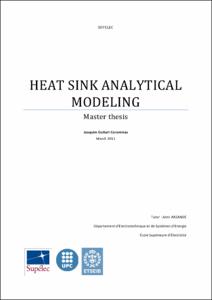Mostra el registre d'ítem simple
Heat sink analytical modelling
| dc.contributor | Arzande, Amir |
| dc.contributor.author | Guitart Corominas, Joaquim |
| dc.date.accessioned | 2012-02-17T11:09:41Z |
| dc.date.available | 2013-07-24T09:27:46Z |
| dc.date.issued | 2010 |
| dc.identifier.uri | http://hdl.handle.net/2099.1/14262 |
| dc.description.abstract | Electronics has leaded most technological advances of the past 60 years. There are technologies with domains particularly developed for electronics such as material science, electromagnetism, system dynamics and also heat transfer. The relation to heat transfer is because the heat generation of electronics devices. Commonly, these devices need additional cooling in order to avoid extreme temperatures inside it. Heat sinks allow this supplementary cooling, so they are omnipresent in electronic assemblies. Heat sink can work by forced convection, natural convection or liquid cooling. Normally in electronic assemblies they are made of materials with good thermal conduction such as aluminum or copper. The heat transfer in sinks is especially by convection, but also by radiation. Radiation heat transfer can represent up to 30% of heat rate in natural convection heat sinks. The manufacturing process is usually by extrusion, but also by cast, bonded, folded, skived and stamped processes. There are a lot of geometries available and they are generally adapted to each specific requirement. However, a very common heat sink profile is the rectangular parallel fin one. This profile forms Uchannels, where the convection phenomenon is able to be modeled by empirical correlations. The radiation process is almost a geometric problem, so its analysis will be a minor order study. The modeling of rectangular parallel fin heat sinks allows an analytical study. This study can lead to determining the parameters of a heat sink for a specific application, mainly for electronics industry. The heat transfer processes that occur in a heat sink are studied in this work. There is also proposed an algorithm for rectangular parallel fin heat sinks and the computation study of its results. These computation results are compared to a finite element program solution in order to know the error of the proposed model. Finally, is suggested an optimization application for this algorithm. |
| dc.language.iso | eng |
| dc.publisher | Universitat Politècnica de Catalunya |
| dc.publisher | École Supérieure d’Electricité |
| dc.rights | Attribution-NonCommercial-NoDerivs 3.0 Spain |
| dc.rights.uri | http://creativecommons.org/licenses/by-nc-nd/3.0/es/ |
| dc.subject | Àrees temàtiques de la UPC::Enginyeria electrònica::Circuits electrònics |
| dc.subject.lcsh | Electronic apparatus and appliances -- Cooling |
| dc.subject.lcsh | Heat -- Transmission |
| dc.title | Heat sink analytical modelling |
| dc.type | Master thesis (pre-Bologna period) |
| dc.subject.lemac | Electrònica Aparells i instruments -- Refrigeració |
| dc.subject.lemac | Calor Transmissió |
| dc.rights.access | Open Access |
| dc.audience.educationlevel | Estudis de primer/segon cicle |
| dc.audience.mediator | Escola Tècnica Superior d'Enginyeria Industrial de Barcelona |
| dc.audience.degree | ENGINYERIA INDUSTRIAL (Pla 1994) |
| dc.description.mobility | Outgoing |


